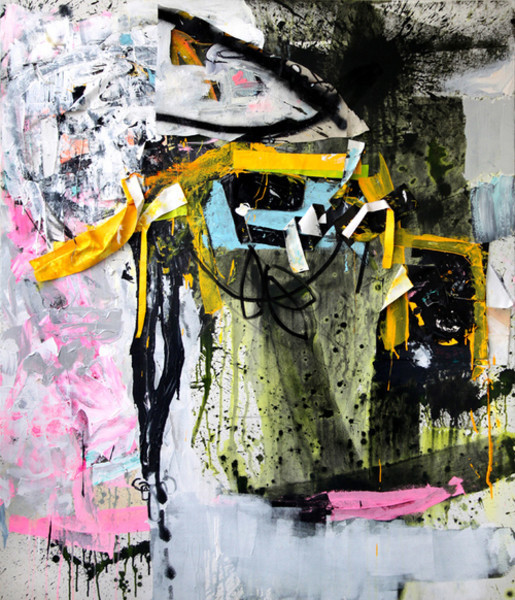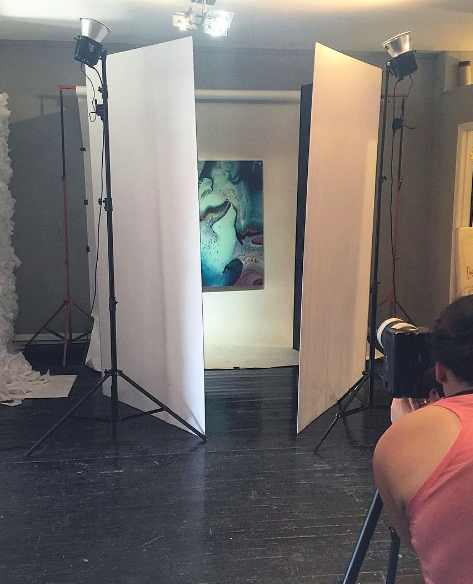
As artists, we spend a ton of time perfecting our craft.
And then, after hours of working on a painting, exhausted and up against a deadline, we often neglect the most important part of the process: photographing the work. Too many of us are a little lost when it comes to the specifics and settle for a few sloppy shots before shipping the artwork out.
Since artists are required to submit work digitally for exhibitions, grants, talks and your public profile page, good photography offers the first impression of your art and your professionalism.
We frequently see artists with incredible artwork, but have images that are shot in dimly lit, sloppy environments that distort the original artwork.
Knowing how to properly photograph your work can mean the difference between being accepted to a show, or winning the favors of an important client or gallery director.
We put together a few guidelines to photographing your artwork so you can begin to photograph your artwork like a pro.

 Howard Sherman shows how he documents his work on his Instagram account. On the right "Edgy Community of Unconventional Types."
Howard Sherman shows how he documents his work on his Instagram account. On the right "Edgy Community of Unconventional Types."
1. Hang your artwork on the wall
We regularly see artwork photographed leaned up against a wall and shot from a downward angle. Find a neutral colored wall (white, black, gray) and hang your work at a height where the middle of your piece will be parallel to where your camera will be—either on a tripod or resting sturdily on a table or other surface.
2. Light your work properly
If you are shooting your work indoors, do so in a room with plenty of windows and natural light. Some artists also enjoy photographing their work outdoors when it is cloudy or overcast, as indirect sunlight provides the best lighting. Natural light can be a beautiful way to photograph your work as long as it is indirect.
If the weather isn’t cooperating, or if you are up against a late-night deadline, you will need to set up a lighting kit. The good news is, you don’t have to spend a ton for a professional setting if you aren’t ready to invest in one.
All you will need is two lights at a minimum for 2-dimensional work. We have used lighting stands that you often see in dorm rooms (the ones with three adjustable bulbs) or clamp lights. Place the lights halfway between the camera and the canvas at a 45-degree angle pointing toward the wall (this will help eliminate shadows and “hot spots” on the painting). If you have umbrellas for your lights, attach them now.


Arthur Brouthers shows how he uses white panels to reflect light and a finished piece "Slipping II" on his Instagram.
LIGHT HACK: If you don’t have professional grade lighting kit, you can easily hack diffusing the light with a white sheet or white plastic between the lights and your work. This helps to evenly distribute the light. Alternatively, a few sheets of white foam core can be set up to simulate a “raking light” effect where the lights are pointed at the foam core and the whiteboard reflects the light back at the piece.
3. Adjust your camera and settings
Once your artwork is secured to the wall, double check that the camera is set to the lens lines up with the middle of the painting. You want to position your camera so that the frame is filled with most of the painting, with a bit of background that you can crop out later. It is important for many juries to see the edges of the paintings to get a sense of scale.
The ISO and aperture of your camera are very important to get clear, crisp and bright images of your artwork. ISO references what film speed used to measure. The higher the number, the more sensitive the film was to light and the coarser the image. In this case, since we want very crisp images, we want a low ISO. Studio shots will generally be shot at ISO 100.
The f-stop of the aperture of your camera adjusts how much light is let through the lens by making the opening bigger or smaller. The higher the number, the less light is being passed through. With a DSLR the ideal range for shooting artworks is between f-8 and f-11.
TIP: Set your camera’s timer to four or five seconds so that pressing the shutter button doesn’t create a shake in your image.
4. Edit your photos to perfection
There are plenty of free or inexpensive photo editing software alternatives out there that will help minimize any inconsistencies. While Photoshop still reigns king, Photoshop Elements or Gimp allow basic functions such as color correction, cropping, and other minor adjustments. Lightroom also offers a subscription-based editing program that professional photographers swear by.
There are, of course, many additional nuances and tricks that could be added to this initial guide. However, if you are looking to improve your photographs and represent yourself professionally on your public profile page, this is a great starting place.





